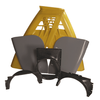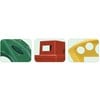RTM and RIM Material Selection for Industry
Featured Product from Osborne Industries, Inc.

Custom thermoset molding services range across a variety of industries, each with a unique set of materials and part specifications. Both the resin transfer molding (RTM) process and reaction injection molding (RIM) process offer specific capabilities that can be applied to virtually any project depending on the manufacturing needs, and they are often customized based on industry.
For example, a molded blower housing for a popular cotton harvester would need to be abrasion-resistant and a louver for the same machine must be impact-resistant, whereas a part for a tanning bed would not necessarily need these qualifiers because of how and where it is used.
Osborne Industries reviews how these processes can differ based on the industry for which they’re manufactured.
WHAT ARE THE RTM AND RIM PROCESSES?
Resin Transfer Molding (RTM), also referred to as liquid molding, is a process that mixes resin with a hardener, or catalyst, and injected into a mold. The mold contains dry fibers, such as fiberglass. The mixture is regulated 100:1 of resin to a catalyst, then injected at low pressure into the mold.
RTM is customizable to a wide range of specifications including:
- Abrasion-resistance
- Color
- Corrosion-resistance
- Flame-resistance
- Hardness
- Impact-resistance
Reaction Injection Molding (RIM) is a process that begins when two liquid reactants are fed through supply lines at high pressure to a mixhead. These liquids are held in separate tanks at an elevated temperature with agitators. They are injected into a chamber at high pressure and speed, and mixed by high-velocity impingement. From the chamber, the combined mixture flows into a mold and undergoes a chemical reaction that forms the part.
RIM offers several advantages, including:
- Customizable wall thickness
- Cost-effective for lower volume parts
- Enables part consolidation
- Lower tooling investment than standard injection molding
- More compact production
- Lower energy usage
INDUSTRIES THAT UTILIZE RTM MATERIALS
At Osborne Industries, we have the ability to gel coat and pigment-match our RTM materials, including fiberglass-reinforced polyester, which gives a very attractive, non-porous surface finish. Some of the industries that commonly look for RTM services include:
- Aerospace: Used for parts such as panels, seat bases, control panels, wheel covers, and door panels
- Agriculture: Used for animal feeding equipment, tractor parts, and”under-hood” pieces for combines or other agricultural equipment
- Bath/Spa: Related to walk-in tub components such as doors, panels, and so forth
- Energy: Parts for wind energy or turbines, as well as solar panel framing
- Industrial Equipment & Construction: This includes machinery covers, columns, cupolas, structural beams, “rebar” for concrete reinforcement, and sewer grates
- Medical Equipment: Covers or body pieces for machines and medical instruments
- Transportation/Military: This is related to truck and tractor fan shrouds and other “under-hood” or internal parts
INDUSTRIES THAT UTILIZE RIM MATERIALS

Osborne often sees industries that use RIM materials such as polyurethane, structural foam, and poly DPCP. Specific uses for these can include:
- Aerospace: Used in the same way as RTM
- Chemical Generation, Wastewater Treatment & Corrosion Control: pDCPD is extremely corrosion-resistant, so its extensively used with chlorine generation and other areas that are exposed to highly-corrosive environments
- Energy: This includes parts for oil and gas manufacturing, pipes and connectors, insulators, motor housings, and engine covers
- Industrial Equipment & Construction: This is very similar to the industrial uses of RTM materials, as well as parts for in-plant service vehicles like forklifts and sweepers
- Transportation: Typically large body parts for vehicles such as buses, campers, and so forth. This could include fenders, grills, hoods, and more.











